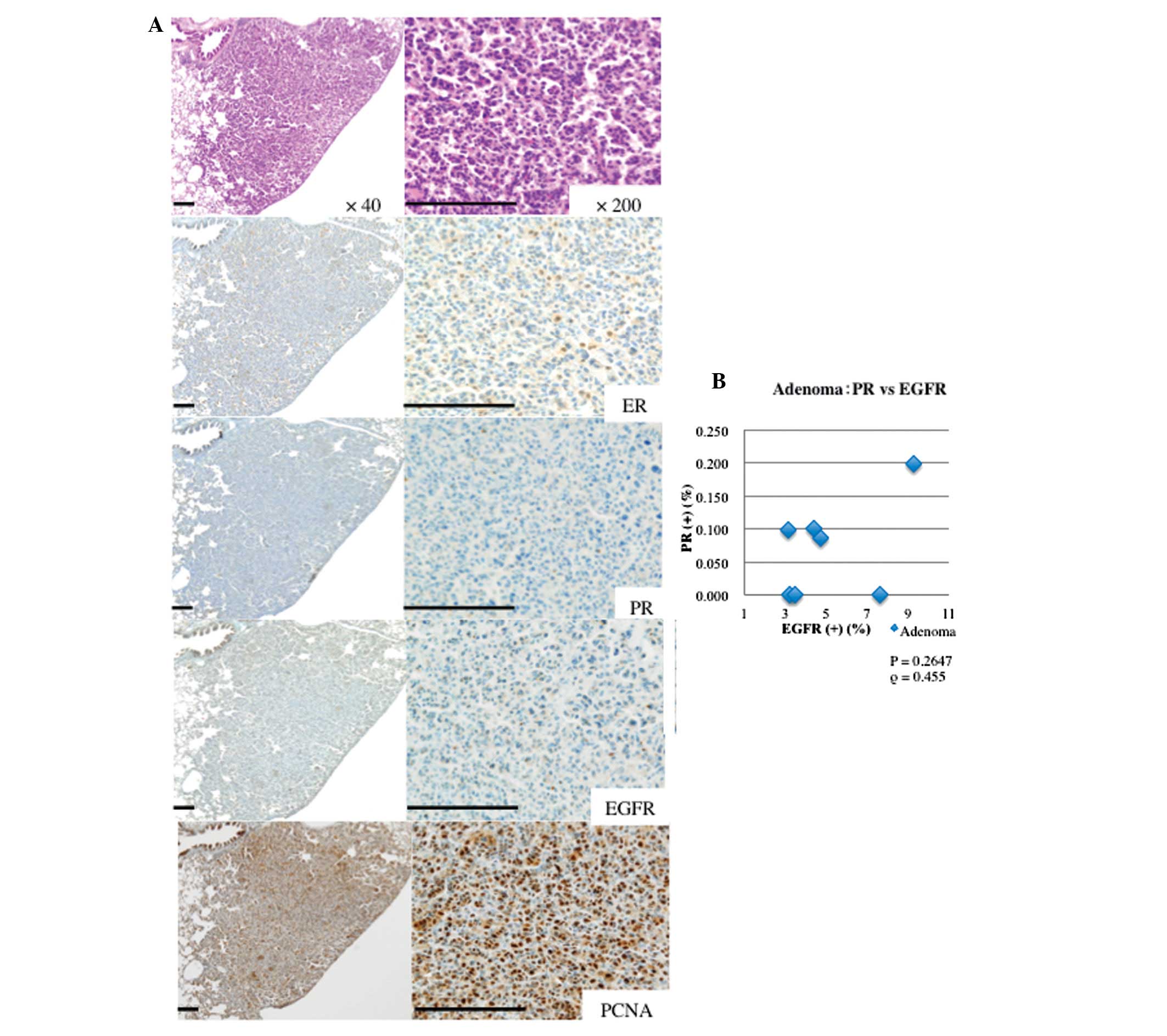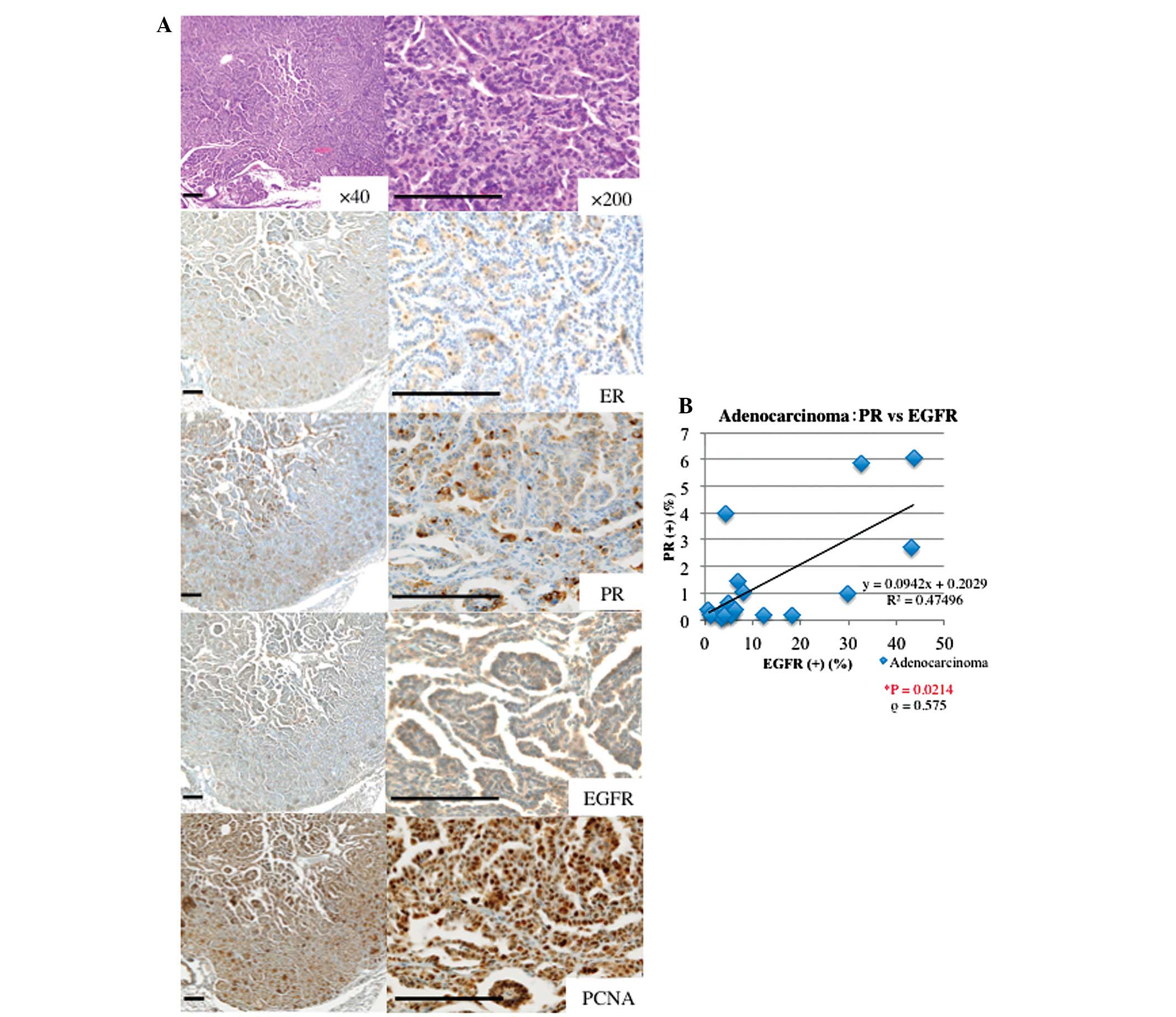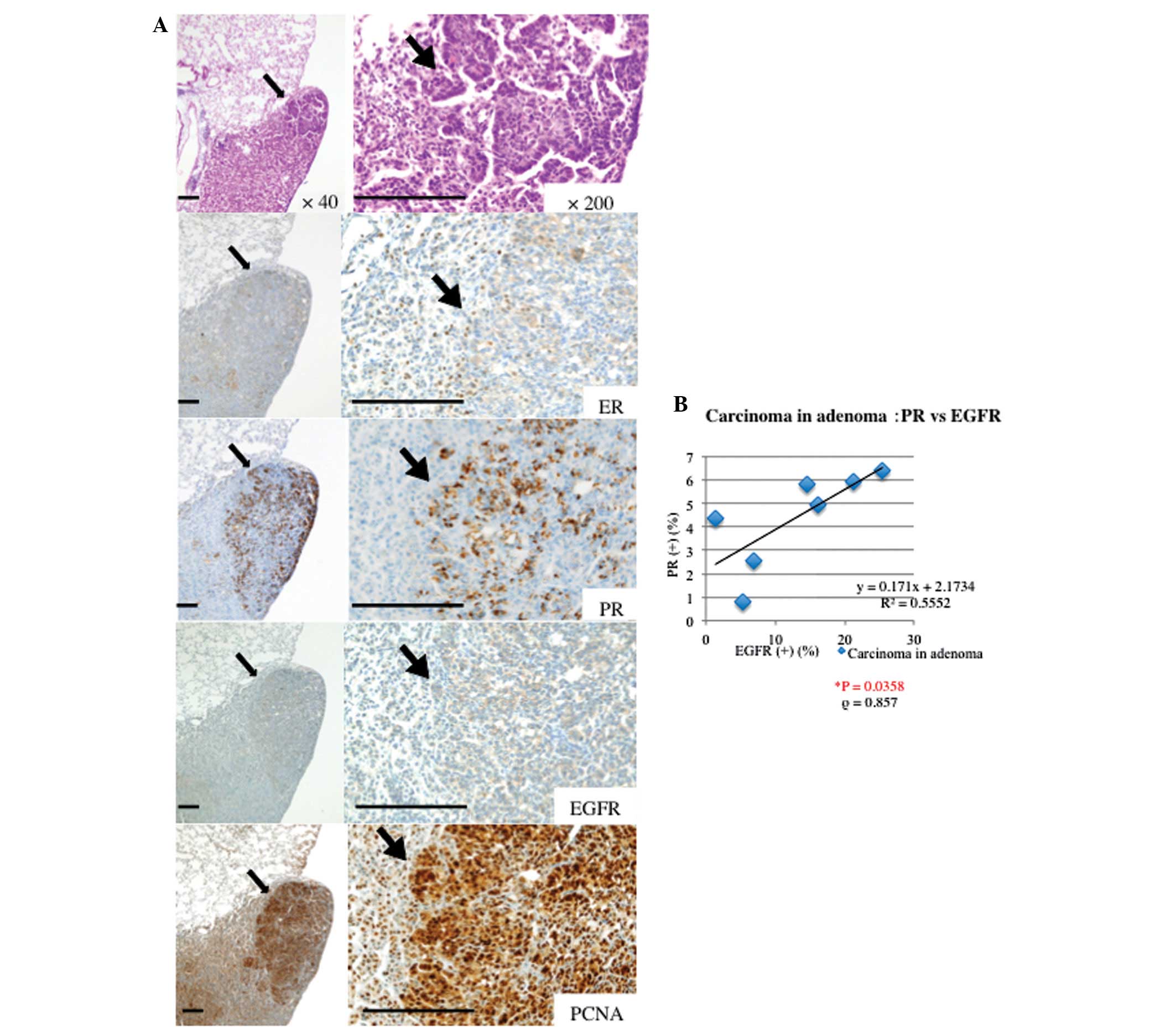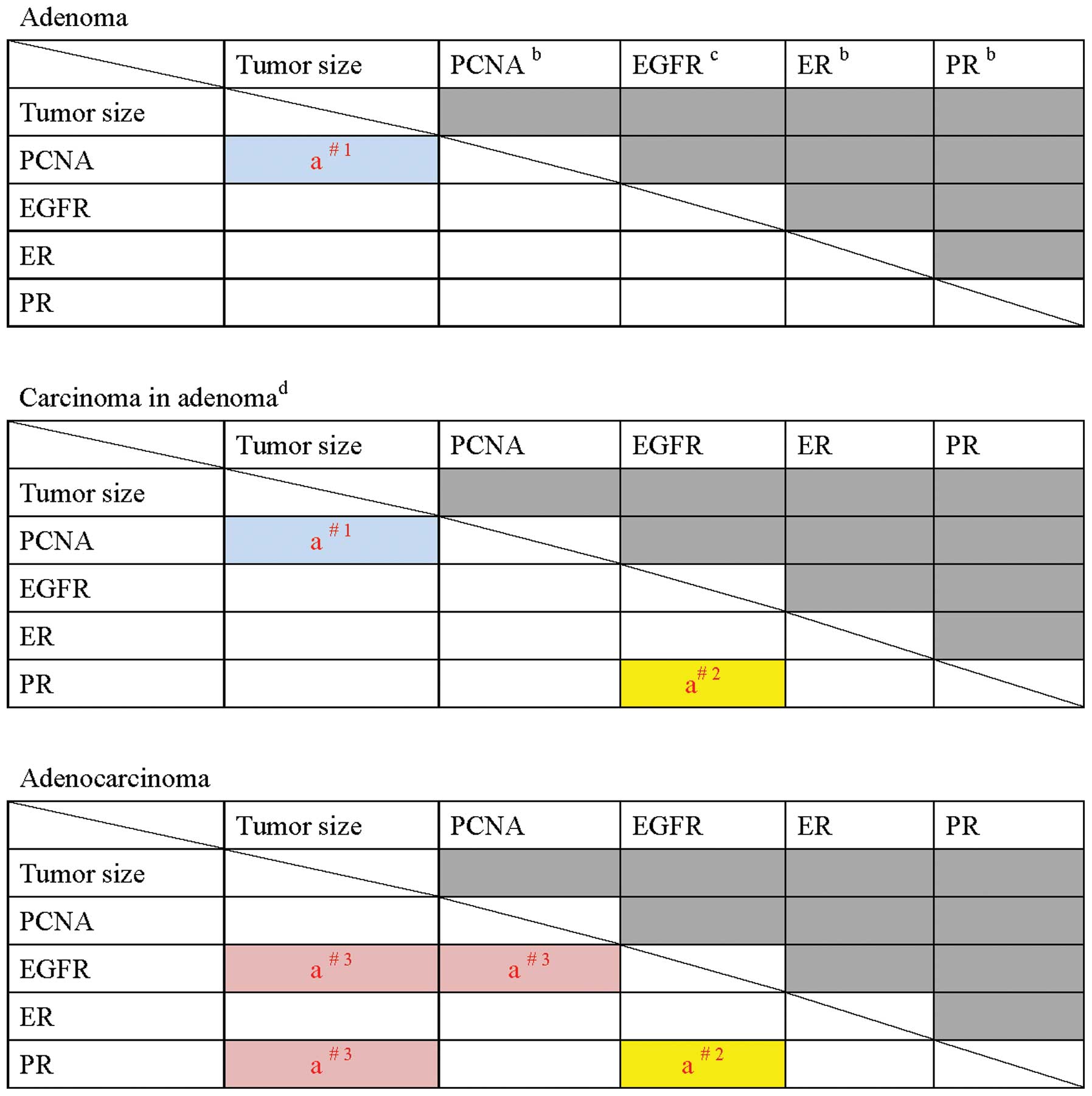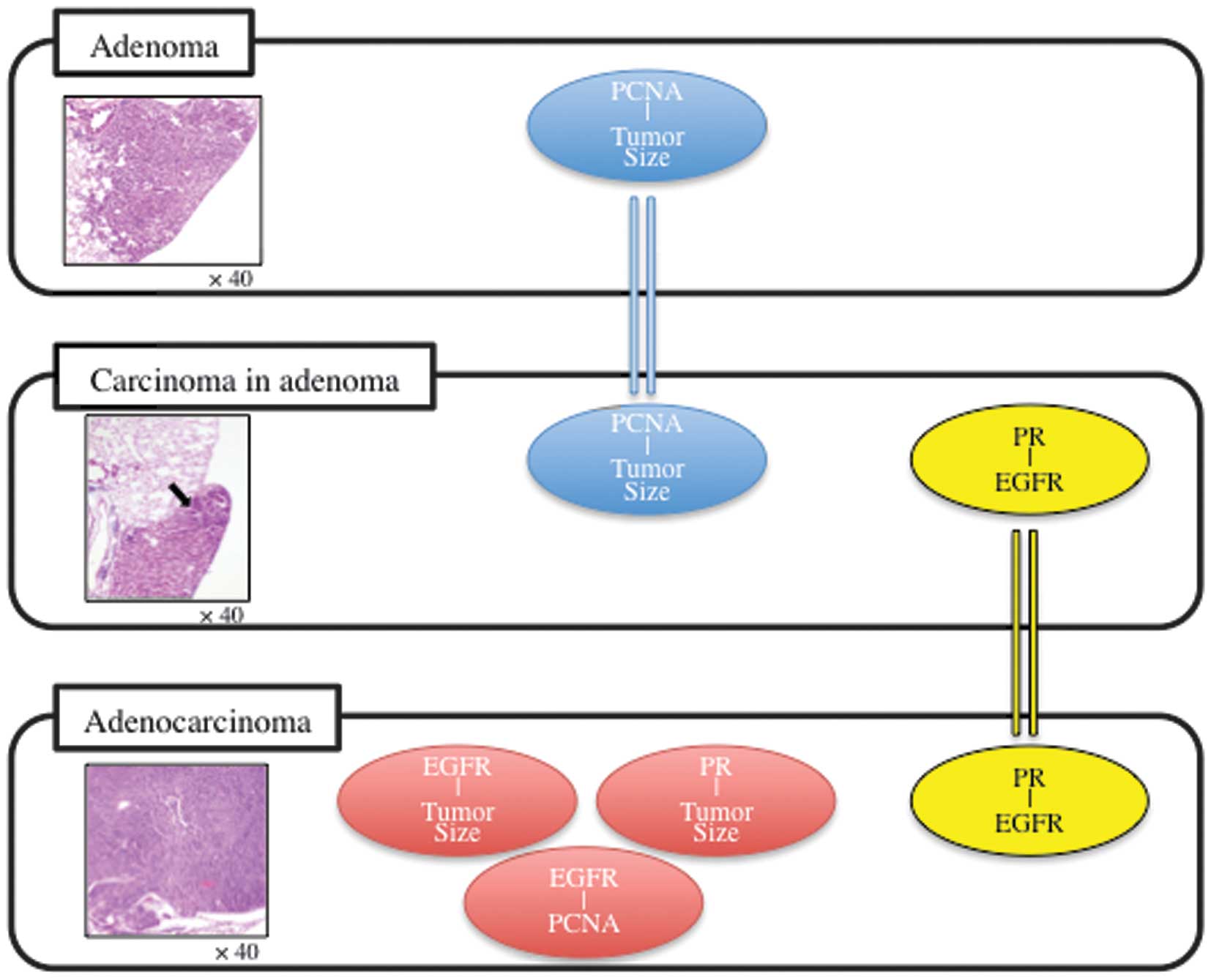|
1
|
Ferlay J, Shin HR, Bray F, et al:
Estimates of worldwide burden of cancer in 2008: GLOBOCAN 2008. Int
J Cancer. 127:2893–2917. 2010.
|
|
2
|
Jemal A, Murray T, Ward E, et al: Cancer
statistics, 2005. CA Cancer J Clin. 55:10–30. 2005.
|
|
3
|
Patel JD, Bach PB and Kris MG: Lung cancer
in US women: a contempory epidemic. JAMA. 291:1763–1768. 2004.
|
|
4
|
Jemal A, Ward E and Thun M: Declining
death rates reflect progress against cancer. PLoS One.
5:e95842010.
|
|
5
|
Subramanian J and Govindan R: Lung cancer
in never smokers: a review. J Clin Oncol. 25:561–570. 2007.
|
|
6
|
Stabile LP, Davis AL, Gubish CT, et al:
Human non-small cell lung tumors and cells derived from normal lung
express both estrogen receptor alpha and beta and show biological
responses to estrogen. Cancer Res. 62:2141–2150. 2002.
|
|
7
|
Niikawa H, Suzuki T, Miki Y, et al:
Intratumoral estrogens and estrogen receptors in human non-small
cell lung carcinoma. Clin Cancer Res. 14:4417–4426. 2008.
|
|
8
|
Taioli E and Wynder EL: Re: Endocrine
factors and adenocarcinoma of the lung in women. J Natl Cancer
Inst. 86:869–870. 1994.
|
|
9
|
Ganti AK, Sahmoun AE, Panwalkar AW,
Tendulkar KK and Potti A: Hormone replacement therapy is associated
with decreased survival in women with lung cancer. J Clin Oncol.
24:59–63. 2006.
|
|
10
|
Weinberg OK, Marquez-Garban DC, Fishbein
MC, et al: Aromatase inhibitors in human lung cancer therapy.
Cancer Res. 65:11287–11291. 2005.
|
|
11
|
Pietras RJ, Márquez DC, Chen HW, et al:
Estrogen and growth factor receptor interactions in human breast
and non-small cell lung cancer cells. Steroids. 70:372–381.
2005.
|
|
12
|
Pietras RJ and Márquez-Garbán DC:
Membrane-associated estrogen receptor signaling pathways in human
cancers. Clin Cancer Res. 13:4672–4676. 2007.
|
|
13
|
Gruber CJ, Tschugguel W, Schneeberger C
and Huber JC: Production and actions of estrogens. N Engl J Med.
346:340–352. 2002.
|
|
14
|
Massaro D, Clerch LB and Massaro GD:
Estrogen receptor-alpha regulates pulmonary alveolar loss and
regeneration in female mice: morphometric and gene expression
studies. Am J Physiol Lung Cell Mol Physiol. 293:L222–L228.
2007.
|
|
15
|
Morani A, Warner M and Gustafsson JA:
Biological functions and clinical implications of oestrogen
receptors alfa and beta in epithelial tissues. J Intern Med.
264:128–142. 2008.
|
|
16
|
Check JH, Sansoucie L, Chern J and Dix E:
Mifepristone treatment improves length and quality of survival of
mice with spontaneous lung cancer. Anticancer Res. 30:119–122.
2010.
|
|
17
|
Raso MG, Behrens C, Herynk MH, et al:
Immunohistochemical expression of estrogen and progesterone
receptors identifies a subset of NSCLCs and correlates with EGFR
mutation. Clin Cancer Res. 15:5359–5368. 2009.
|
|
18
|
Su J-M, Hsu HK, Chang H, et al: Expression
of estrogen and progesterone receptors in non-small-cell lung
cancer: immunohistochemical study. Anticancer Res. 16:3803–3806.
1996.
|
|
19
|
Stabile LP, Dacic S, Land SR, et al:
Combined analysis of estrogen receptor beta-1 and progesterone
receptor expression identifies lung cancer patients with poor
outcome. Clin Cancer Res. 17:154–164. 2011.
|
|
20
|
Skov BG, Fischer BM and Pappot H:
Oestrogen receptor beta over expression in males with non-small
cell lung cancer is associated with better survival. Lung Cancer.
59:88–94. 2008.
|
|
21
|
Di Nunno L, Larsson LG, Rinehart JJ and
Beissner RS: Estrogen and progesterone receptors in non-small cell
lung cancer in 248 consecutive patients who underwent surgical
resection. Arch Pathol Lab Med. 124:1467–1470. 2000.
|
|
22
|
Lynch TJ, Bell DW, Sordella R, et al:
Activating mutations in the epidermal growth factor receptor
underlying responsiveness of non-small-cell lung cancer to
gefitinib. N Engl J Med. 350:2129–2139. 2004.
|
|
23
|
Pao W, Miller V, Zakowski M, et al: EGF
receptor gene mutations are common in lung cancers from ‘never
smokers’ and are associated with sensitivity of tumors to gefitinib
and erlotinib. Proc Natl Acad Sci USA. 101:13306–13311. 2004.
|
|
24
|
Paez JG, Jänne PA, Lee JC, et al: EGFR
mutations in lung cancer: correlation with clinical response to
gefitinib therapy. Science. 304:1497–1500. 2004.
|
|
25
|
Giaccone G: Epidermal growth factor
receptor inhibitors in the treatment of non-small-cell lung cancer.
J Clin Oncol. 23:3235–3242. 2005.
|
|
26
|
Han SW, Kim TY, Hwang PG, et al:
Predictive and prognostic impact of epidermal growth factor
receptor mutation in non-small-cell lung cancer patients treated
with gefitinib. J Clin Oncol. 23:2493–2501. 2005.
|
|
27
|
Shigematsu H, Lin L, Takahashi T, et al:
Clinical and biological features associated with epidermal growth
factor receptor gene mutations in lung cancers. J Natl Cancer Inst.
97:339–346. 2005.
|
|
28
|
Mitsudomi T, Kosaka T, Endoh H, et al:
Mutations of the epidermal growth factor receptor gene predict
prolonged survival after gefitinib treatment in patients with
non-small-cell lung cancer with postoperative recurrence. J Clin
Oncol. 23:2513–2520. 2005.
|
|
29
|
Jänne PA, Engelman JA and Johnson BE:
Epidermal growth factor receptor mutations in non-small-cell lung
cancer: implications for treatment and tumor biology. J Clin Oncol.
23:3227–3234. 2005.
|
|
30
|
Pao W and Miller VA: Epidermal growth
factor receptor mutations, small-molecule kinase inhibitors, and
non-small-cell lung cancer: current knowledge and future
directions. J Clin Oncol. 23:2556–2568. 2005.
|
|
31
|
Imaida K, Yokohira M and Kuno T: Detection
of carcinogenic and modifying potentials by test compounds using a
mouse lung carcinogenesis bioassay. J Toxicol Pathol. 20:117–123.
2007.
|
|
32
|
Yamakawa K, Kuno T, Hashimoto N, et al:
Molecular analysis of carcinogen-induced rodent lung tumors:
Involvement of microRNA expression and Kras or Egfr mutations. Mol
Med Rep. 3:141–147. 2010.
|
|
33
|
Takeuchi H, Saoo K, Matsuda Y, et al:
8-Methoxypsoralen, a potent human CYP2A6 inhibitor, inhibits lung
adenocarcinoma development induced by 4-(methylnitrosamino)
-1-(3-pyridyl)-1-butanone in female A/J mice. Mol Med Rep.
2:585–588. 2009.
|
|
34
|
Renne R, Brix A, Harkema J, et al:
Proliferative and nonproliferative lesions of the rat and mouse
respiratory tract. Toxicol pathol. 37:5S–73S. 2009.
|
|
35
|
[No authors listed]. The Coronary Drug
Project. Findings leading to discontinuation of the 25-mg day
estrogen group. JAMA. 226:652–657. 1973.
|
|
36
|
Chlebowski RT, Schwartz AG, Wakelee H, et
al: Women’s Health Initiative Investigators: Oestrogen plus
progestin and lung cancer in postmenopausal women (Women’s Health
Initiative trial): a post-hoc analysis of a randomised controlled
trial. Lancet. 374:1243–1251. 2009.
|
|
37
|
Slatore CG, Chien JW, Au DH, Satia JA and
White E: Lung cancer and hormone replacement therapy: association
in the vitamins and lifestyle study. J Clin Oncol. 28:1540–1546.
2010.
|
|
38
|
Chlebowski RT, Anderson GL, Manson JE, et
al: Lung cancer among postmenopausal women treated with estrogen
alone in the women’s health initiative randomized trial. J Natl
Cancer Inst. 102:1413–1421. 2010.
|
|
39
|
Kitahashi T, Takahashi M, Yamada Y, et al:
Occurrence of mutations in the epidermal growth factor receptor
gene in X-ray-induced rat lung tumors. Cancer Sci. 99:241–245.
2008.
|
|
40
|
Gealy R, Zhang L, Siegfried JM, Luketich
JD and Keohavong P: Comparison of mutations in the p53 and K-ras
genes in lung carcinomas from smoking and nonsmoking women. Cancer
Epidemiol Biomarkers Prev. 8:297–302. 1999.
|
|
41
|
Hainaut P and Pfeifer GP: Patterns of p53
G → T transversions in lung cancers reflect the primary mutagenic
signature of DNA-damage by tobacco smoke. Carcinogenesis.
22:367–374. 2001.
|
|
42
|
Zerbe LK, Dwyer-Nield LD, Fritz JM, et al:
Inhibition by erlotinib of primary lung adenocarcinoma at an early
stage in male mice. Cancer Chemother Pharmacol. 62:605–620.
2008.
|



